Agricultural Reform School, Ruysselede (Ruiselede), West Flanders, , Belgium
In 1848, the Belgian government passed legislation to construct special establishments for the reception of young paupers, beggars and vagrants, under the age of sixteen, who had previously been accommodated alongside adults in almshouses or prisons. These new institutions, known as reform schools, were to be organized to employ the boys, as much as possible, in agriculture, and to instruct them in such labour as might be profitably employed in the fields. Girls were to be placed in completely separate establishments. The running costs of the schools was to be borne by the communes of each province, with central funding provided for the land, buildings and fitting-out of the premises. The first school, for 600 boys, was established in 1849 on what is now Bruggesteenweg, in the commune of Ruysselede (now Ruiselede), West Flanders, to the south-east of Bruges. In 1853, a school for 400 girls was opened in the neighbouring commune of Beernem.
The first pupils entered in March, 1849, shortly after the purchase of the property and the start of the preparatory work. The first admissions were 19 boys from the Bruges alms-house at Bruges, then 15 from that of Combre. They were followed by 63 young beggars and vagrants acquitted by the courts but who had been placed in the juvenile penitentiary of Saint Hubert, for want of any better accommodation. These, with 24 received individually during the same time, make a total of 121 pupils on the 1 January 1850.
Young paupers entering the reform schools voluntarily were kept for at least six months on their first admission, and for at least one year, if they had been in the school before, or if they had previously been inmates of an alms-house. At the end of that time, the civil authority of their place of settlement, their family, or any responsible person, could claim their release, after agreeing to provide for their education, apprenticeship, and support. In the absence of any such claims, the pupil could be released, provided he was in a condition to earn his own living. To qualify for release, the pupil had to have remained at least two years in the reform school, if sent there for the first time, and at least four years, if he was a previous offender.
The school occupied the premises of a former sugar-house, altered and enlarged for its new use, together with 500 acres of land. A new road was built to provide direct access to the Bruges-Ghent canal and the Gand-Bruges railway, which had a station at Bloemendael. To facilitate the transport of manure to the school site, a wharf and a large cistern were constructed at the edge of the canal. In the main building, the offices and accommodation of the officers occupied the two wings towards the road. The central building contained, on its ground floor, two school-rooms and the boys' and officers' dining-rooms. On the first floor were four large dormitories, each with 124 cots, a superintendent's chamber, and wash-stands for the pupils. In the garret was a large reservoir filled by a five-horse-power steam-engine, which distributed water to all parts of the establishment. The rooms on the first floor were warmed by a furnace. The steam engine also provided heat and power for cooking, warming the main building, and milling grain.
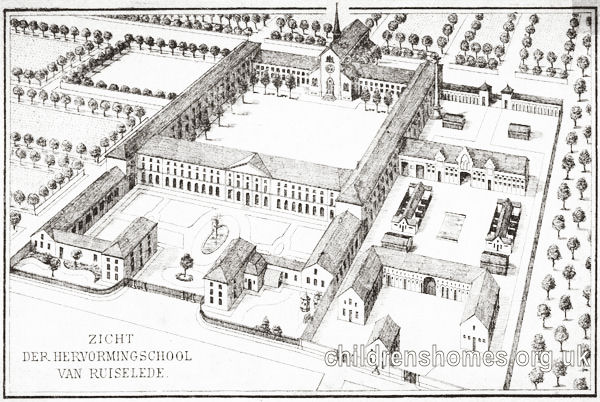
Agricultural Reform School, Ruysselede.
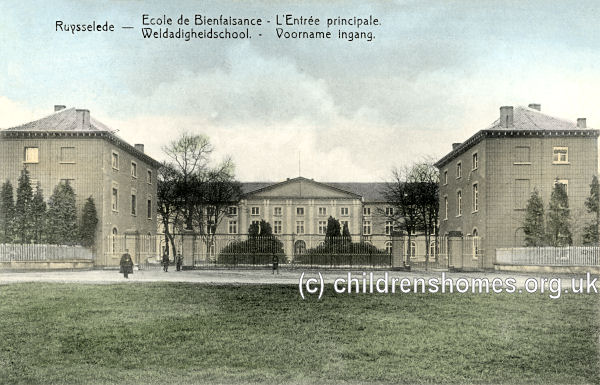
Main building at Agricultural Reform School, Ruysselede, early 1900s. © Peter Higginbotham
To the right of the central building, facing from the road, were the boys' kitchen, the bakery, the steam-engine, the pantry and the store-rooms. To the left were the officers' kitchen, a plunge-bath, baths, a fire-pump and, on the upper floor, the boys' infirmary. A playground was bounded on three sides by a single-storey building, above which were granaries. In this building were the workshops, the forge, carpenter's shop, spinning and weaving rooms, the tailor's, shoemaker's and straw-weaver's shops, and a temporary wash-house. The chapel stood at one corner and near to it was a small cell to house boys sent to the school for punishment, and for pupils needing discipline or quarantine.

Boys on parade at Agricultural Reform School, Ruysselede, early 1900s. © Peter Higginbotham
The farm buildings, standing near the school, included a house for the farmer and the farm labourers, stables for 80 to 100 head of cattle, a dairy, two stables for 12 horses, two piggeries, a sheep-fold, a poultry-yard, two covered receptacles for manure, a barn, and a large carriage house for vehicles and farming tools, over which are lofts for hay.
The boys' diet was based upon an an expenditure of about 21 centimes a day for each pupil, a n amount which was at that time lower than in any other similar establishment in Belgium or any other country. The pupils nevertheless had meat twice a week, for which hogs were killed on the farm, and their flesh served up alternately with beef. The bread was made from rye, unbolted. The grain, potatoes, legumes, milk, and butter, were all the product of the establishment.
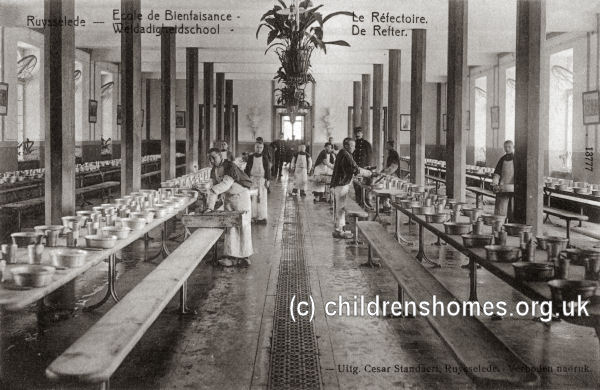
Refectory at Agricultural Reform School, Ruysselede, early 1900s. © Peter Higginbotham
Up to 300 of the boys were employed in farm work, with preference given to those from the countryside. They worked the soil, sowed and planted, with the younger ones hoeing or weeding, while the older and stronger were employed in harvesting and threshing. One contingent were attached to the farm, where its members in regular rotation were employed at the stables, the hog-pens, the poultry-yard, the manure heaps, the dairy, etc. Another group were employed in the kitchen garden.
A variety of manual trades was also taught at the school including those of the blacksmith and locksmith, carpenter, wheelwright, cooper, tailor, basket-maker, and straw-weaver. A fully equipped spinning and weaving shop contained sixty spinning-wheels, six twisting machines, nine bobbin machines, one reel, and six warp machine.
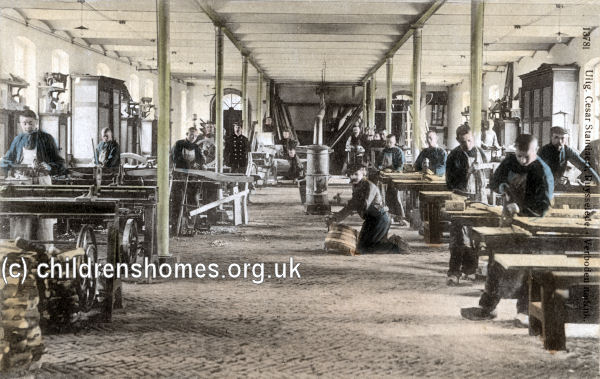
Carpentry workshop at Agricultural Reform School, Ruysselede, early 1900s. © Peter Higginbotham
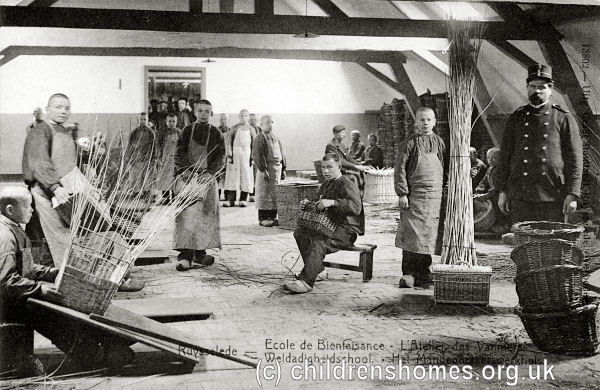
Basket making at Agricultural Reform School, Ruysselede, early 1900s. © Peter Higginbotham
As well as their agricultural or manual work, the boys received classroom education in the evenings. The studies, pursued alternately in French and Flemish, included reading, writing, grammar, dictation, intuition, exercise of memory, arithmetic, mental and written, the legal system of weights and measures, general geography, the history of the country, the rudiments of linear drawing, and vocal and instrumental music. A hour-long singing lesson took place each morning. A military band was established in 1850, with a master attending twice a week from Bruges.
Physical exercise also formed an important part of the boys' activities and they learned the art of fencing. In 1852, the teaching of navigation and other nautical skills was introduced. An Antwerp ship-owner, Mr Huysmans-Vandenberge, donated a fully-rigged schooner-brig to the school to assist in the training. The scheme proved successful and in 1855, a separate naval training branch of the school was established a short distance away in the commune of Wynghene (now Wingene).
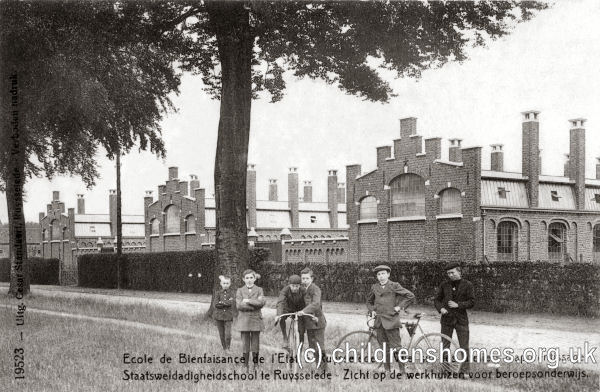
Apprentice workshops at Agricultural Reform School, Ruysselede, early 1900s. © Peter Higginbotham
The school's daily timetables in the 1850s are shown below.
| Summer Monday-Saturday | |
|---|---|
| 5.00 | Rise |
| 5.00-5.30 | Prayers, washing, bed-making, roll-call. |
| 5.30-6.30 | Exercise and manouevres. |
| 6.30-6.45 | Breakfast. |
| 6.45-7.00 | Arrangement of labour. |
| 7.00-11.00 | Working hours. |
| 11.00-12.00 | Singing class, band practice. |
| 12.00-12.15 | Dinner. |
| 12.15-1.00 | Play. |
| 1.00-5.30 | Working hours. |
| 5.30-5.45 | Supper. |
| 5.45-7.30 | School instruction. |
| 7.30-8.45 | Gymnastics. |
| 8.45-9.00 | Roll-call, reports. |
| 8.30 | Prayers, bedtime. Saturday 5.00-8.00 cleaning workshops, baths etc. |
| Winter Monday-Saturday | |
|---|---|
| 5.00 | Rise |
| 5.00-5.45 | Prayers, washing, bed-making, roll-call. |
| 5.45-6.45 | Singing class. |
| 6.45-7.00 | Breakfast. |
| 7.00-7.15 | Arrangement of labour. |
| 7.15-12.00 | Working hours. |
| 11.00-12.00 | Band practice. |
| 12.00-12.15 | Dinner. |
| 12.15-1.00 | Play. |
| 1.00-2.00 | Gymnastics and military exercises. |
| 2.00-5.45 | Working hours. |
| 4.45-5.45 | Catechism for children not having received their first communion. |
| 5.45-6.00 | Supper. |
| 6.00-8.00 | School instruction. |
| 8.00-8.30 | Roll-call, reports. |
| 8.30 | Prayers, bedtime. Saturday 1.00 to 4.45 cleaning workshops, baths etc. |
| Sundays and Feast-days all year | |
|---|---|
| 5.00-5.30 | Rise, prayer, washing etc. |
| 5.30-7.30 | Clothes, inspection, bed, etc. |
| 7.30-8.00 | Breakfast. |
| 8.00-8.45 | Play. |
| 8.45-9.30 | Mass, sermon. |
| 9.45-11.00 | Singing class. |
| 11.00-12.00 | Play, games. |
| 12.00-12.15 | Dinner. |
| 12.15-2.00 | Play games. |
| 2.00-4.00 | Catechism and religious instruction. |
| 4.00-5.45 | Gymnastics, military exercises, or walk.. |
| 5.45-6.00 | Supper. |
| 6.00-8.00 | School instruction. |
| 8.00-8.30 | Roll-call, report. |
| 8.30 | Prayers, bedtime. |
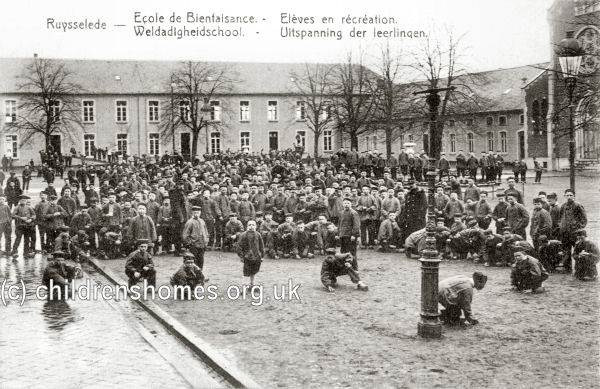
"Boys at play at Agricultural Reform School, Ruysselede, early 1900s. © Peter Higginbotham
The school's name changed over the years. Originally described as an École de Réforme (reform school), it changed in the 1880s to become an École Agricole (agricultural school), and again by the early 1900s to École de Bienfaisance (school of benevolence, or Weldadigheidschool in Dutch).
The school continued in operation until 1965. The premises are now partly occupied by De Zande, a youth welfare institution for boys aged from 12 to years old, and partly by a prison, the Ruiselede PLC (Penitentiair Landbouw Centrum).
Records
Note: many repositories impose a closure period of up to 100 years for records identifying individuals. Before travelling a long distance, always check that the records you want to consult will be available.
- None identfied at present — any information welcome.
Bibliography
- Ducpétiaux, Edouard Exposé de la situation des écoles de reéforme de Ruysselede, de Wynghene et de Beernem: 1849-1858 (Bruxelles, 1861)
- Morier, Alois Un Siècle de l'Établissement d'l'Éducation de l'État a Ruielede (1949, Office de la Protection de 'Enfance)
Links
- None identified at present.
Except where indicated, this page () © Peter Higginbotham. Contents may not be reproduced without permission.


